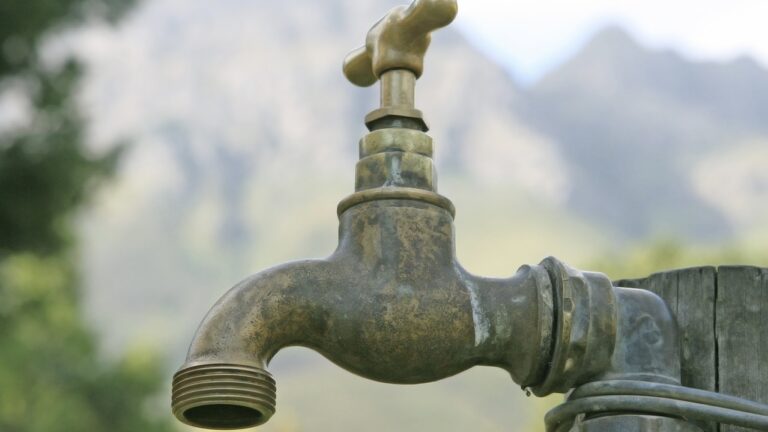
If you’re new to RVing, figuring out RV water hookups may seem a little foreign at first. Not to worry! These hookups are actually pretty straightforward. Read on and you’ll be showering, washing dishes, and flushing in no time.
This post contains affiliate links. RVshare may receive compensation if you make a purchase after clicking on a product link.
Using Water Hookups at a Campground
Generally speaking, if you’re staying at a campground that offers hookups, connecting to the water hookup on your site is the easiest way to get running water in your rig. All you need to do is connect your hose to their water hookup and turn on the spigot to have clean running water at all of your RV faucets.
Here’s how to do it:
- Find the freshwater drinking hose for your RV, motorhome, or trailer. This will be white or blue and should only be used for drinking water.
- Attach a water pressure regulator to one end of the hose to protect your water line from too much pressure.
- Screw the other side of the pressure regulator into the campground water supply hookup, so the hose is connected to the spigot.
- Connect the other end of the water hose to the RV city water hookup. Usually, there is a label on the outside of the RV to indicate where this is.
- Turn the water on by lifting the level or turning the knob at the spigot.
- Check the water pressure at the sinks and shower and adjust as needed.
- Turn on your RV water heater if wanted.
- That’s it! You’re ready for a nice, hot shower after a long day of driving and setting up camp!
Disconnecting from RV Water Hookups
Disconnecting from the campground water spigot is just as easy as hooking up. Follow the steps below and you’ll be ready to hit the road.
- Turn the water heater off.
- Turn off the water at the spigot.
- Detach the freshwater hose from the RV city water inlet by turning it counterclockwise.
- Disconnect the hose from the spigot, making sure your water pressure regulator comes with it.
- Lift the hose to ensure any leftover water drains out before coiling it and putting it away.
- If your city water inlet includes a plug to keep debris out, be sure to replace this before hitting the road.
Adding a Water Filter to Your Freshwater Hose
Because campground water isn’t always the best drinking water, many RVers choose to use water filters, cleaning all water before it ever enters their rig. If you wish to add a water filter to your setup, we recommend buying an inline filter that screws into place between the water hookup and the freshwater hose. These twist into place quickly and easily and are super simple to replace when the time comes.
Connecting Your RV Water at Home
Want to use your RV water while parked at home? You can also use the spigot on the outside of your house to get running water to your RV. Simply follow the instructions above, using the faucet outside of your home rather than the campground RV water hookup and you’ll be in business.
Don’t want to use your outside faucet for your RV? It is also possible to add a dedicated RV water hookup to your yard.
Using the RV Freshwater Tank
If you’re camping with no hookups – called boondocking or dry camping – you’ll want to use an RV water hookup or another water source to fill up your freshwater tank before you go. This will allow you to use your stored water to operate these appliances while you’re away from civilization. When using water from the fresh tank, a water pump ensures that the water gets pumped through your RV to the different appliances where you need it.
Keep in mind, you will need to conserve water if you are using water from the fresh tank and have no way to refill easily.
Using RV Wastewater Tanks
After water from the fresh tank or the city water hookup is used, it goes to one of two tanks, to be held as waste water until you can drain it. Therefore, your RV has two separate wastewater tanks.
The Gray Water Tank
The gray water tank holds water that goes down all drains in the sinks and the shower. This includes water you use while brushing teeth, washing dishes, and showering.
The Black Water Tank
The black water tank holds all the water that has been flushed down toilets in the RV. It’s also sometimes called the septic tank and holds all the waste.
At the end of your camping trip or when the tanks fill up, you’ll want to empty both the gray and black tanks as well as your freshwater tank if you don’t anticipate using it again soon. Most campgrounds have a dump station where you can empty tanks and some even have sewer hookups, making it easy to dump your tanks right at your site.
There you have it, everything you need to know about RV water hookups. Now it’s time to rent an RV so you can try using these hookups for yourself!

